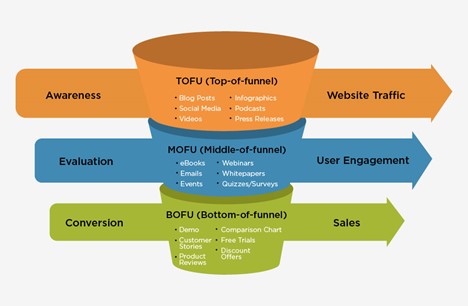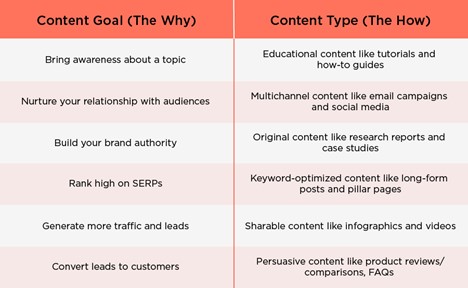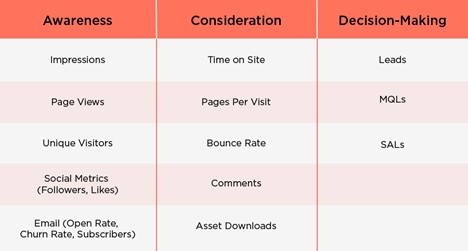Done well, content marketing helps businesses build brand awareness, increase visibility, and generate more leads—ultimately driving sales and growth. Yet, many businesses struggle with their content marketing.
It takes a ton of effort to create great content that provides value to audiences and delivers on your KPIs. And although you may be focused on creating quality content, inevitably some critical mistakes end up diminishing the impact you want to have.
To harness the full power of your B2B content marketing, here are the five biggest mistakes you need to avoid.
Mistake #1: Lack of a Content Strategy
Fully 64% of the most successful B2B content marketers have a documented content strategy, compared with just 19% who do among the least successful.
In the absence of a strategy, most businesses tend to create content that has inconsistent messaging and confuses audiences. When that happens, you lose your prospects early in the customer journey, without gaining any tangible benefits from your content marketing efforts.
A well-defined content strategy for achieving your organization's goals can help you create content that reaches the right audience at the right time to move them down the marketing and sales funnel.

Keep in mind that every content piece you create must have a specific objective attached to it. But don't try to tick all the boxes with one piece; that will only weaken its effectiveness.
For your content to be most effective, ask yourself what purpose it serves. Is it to generate leads and build engagement, enhance brand reputation, increase keyword presence?
Based on your "why," choose an appropriate "how" to begin with your content creation:

Mistake #2: Limited Access to the Right Resources
Let's face it: Creating content—from coming up with a good idea to bringing it to life—is challenging. A lot of research and expertise is required.
Often, content creators do not have the time, resources, and capabilities to create in-depth content on their own. The result is a half-baked write-up that does increase your asset quantity but fails to add value for readers.
Access to the right resources is crucial for content marketing. Having a knowledge bank can help.
You knowledge bank might include...
- A content matrix of published resources that can be used for interlinking
- A content repository that can help in creating new content on a topic
- Subject-matter experts' insights for technical information and accuracy
- Brand guidelines and position on a specific topic
Content marketers should also have access to one of the most effective sources of content inspiration: their own customers.
"Content teams should be as close to the customer as the rest of the marketing team—listening to sales/customer service calls, taking part in customer interviews, and reviewing customers' own content", says Bethan Vincent, Fractional CMO at Open Velocity. "The insight gathered from these activities is invaluable to creating content that is actually going to resonate with someone."
Mistake #3: Little Reusability or Distribution
Creating content with a one-and-done approach is another mistake that many content marketers make. If you create only new content and forget about your old assets, you are missing out on a big opportunity.
Content repurposing helps you do more with less. By converting your existing content into diverse content formats, you can increase its shelf-life.
For example, you can compile your similar topic blog posts into an e-book, turn podcasts into blog posts, create video content from written content, and convert case studies into articles or infographics.
You also need to diversify your distribution. A typical content marketing funnel focuses mostly on generating leads and works this way:
- You publish content on the website.
- To attract website visits, you promote the content link on various platforms.
- Clicking on the link takes audiences to your webpage.
However, the problem is that people hardly click on the links you share. They don't like leaving their current content ecosystem to go elsewhere for a single piece of content you shared.
So, you need to play by their rules and tailor your content according to the platform they are on. Instead of sharing blog post links, repurpose them into Twitter threads with key takeaways, or turn that blog post into a video and share it on Instagram for higher engagement.
Mistake #4: Poor SEO Strategy
If you focus too much on keyword optimization in your content without accounting for search intent, you are actually hurting your SEO results.
Let's understand this idea with an example. Say you create a blog post titled "Benefits of e-commerce website development" and optimize it for a high-volume keyword such as "e-commerce website development" to rank on SERPs.
In this case, your content is informational while your keyword is transactional. So, even if you do manage to rank for it, you won't get the right kind of traffic because someone searching for "e-commerce website development" is likely looking to invest in a service, whereas your content is telling them its benefits.
In the age of semantic search, context is the key to your SEO strategy. Therefore, instead of embarking on keyword research to create SEO-friendly content, think first of your ideal customers. Zero in on the problem they are trying to solve with their search that uses a specific keyword. Then create comprehensive content around that intent for better chances of ranking in the search engine's context-focused results.
"With search getting smarter, your content's No. 1 priority is to be contextually relevant to the end-users," says Alok Ramsisaria, CEO of Grazitti Interactive. "The content must empathize with the audiences in every way possible, to gain trust and brand authority that'll help rank high on SERPs and build long-term relationships as well."
Mistake #5: Not Enough Performance Tracking
Content marketing is all about persuading your audience to take the action you want them to take. However, without looking at the data, there's no way of knowing what's working and what's not.
To determine the success of your content marketing, you need to track the right metrics that align with your content goals.
Here are some common metrics you should track for each stage of the content marketing funnel:

Review your content marketing performance regularly, and on the basis of what you find...
- Double-down on the type of content that's performing better than expected
- Cut down the type of content that isn't working to focus on other initiatives
From time to time, also analyze your competitors' content and the latest market trends to update your content strategy and keep things interesting.
* * *
There are a lot of ways to get your B2B content marketing wrong. Avoiding the five serious mistakes in this article will help you create a successful content marketing program that produces desired results.
However, once you've figured out your content marketing approach, don't limit yourself—expand beyond it. Keep experimenting with your content to explore new opportunities and audiences. Being receptive to new ideas is the hallmark of a future-proof content marketer.
More Resources on Content Marketing Mistakes
Top 10 Content Marketing Strategy Mistakes, and How to Correct Them (Part 1 of 3)
These Mistakes Can Make Your Content Marketing an Epic Failure (but You Can Avoid Them)
Three Reasons Most Content Marketing Fails, and What to Do About Them




